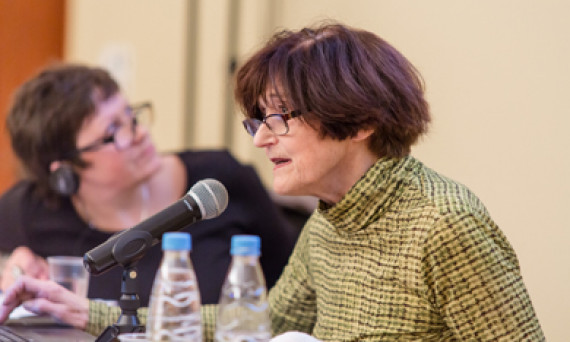EUSP hosted the 13th meeting of the project "Manifesta 10: Dialogues” in the Conference Hall. Lyudmila Bredikhina and Silvia Eiblmayr are researchers and curators working on projects in the field of gender studies, and they presented different views on the problem of the representation and perception of the female body in art. The dialogue was structured as two statements “in painting”: Bredikhina and Eiblmayr limited their commentaries to the images and expressed several hypotheses on their subject.
The seed of the problem of representing the female body in art lies in the classical tradition of painting the female body as an object at which the appraising male gaze is directed.
Eiblmayr began her presentation with Edouard Manet’s “Olympia.” “Olympia” marks the beginning of a transformation in tradition: the woman responds to the gaze that is directed at her. She is not ashamed of her naked body and confronts the viewer with her gaze. Also significant is the change of status of the woman depicted in the painting; if, as a rule, women were represented in classical painting as goddesses or nymphs, then Manet’s Olympia is a prostitute. In the 20th century, several conceptual paradigms for “constructing the gaze” arose: Foucault focused on the increasing power of the gaze as a manifestation of power, while Lacan described it as an unseen though tangible and frightening object.
The female means of self-reflection, of self-awareness in the world, is a reflection of how she is visible to others. Gonsidering three contemporary artists and Manifesta 10 participants — Maria Lassnig, Marlene Dumas and Nicole Eisenman — as an example, Eiblmayr showed how they attempted to break the paradigm of “woman as the object of man’s gaze.” This was closely related to the deconstruction of the paradigm of the gaze in general, relevant to art at the beginning of the century. As an example we can refer to Picasso’s “Le Demoiselle d’Avignon” or a scene from Buñuel and Dali’s film “Un Chien Andalou.”
Valie Export continued this line in her famous 1968 performance called “Tap and Touch Cinema,” where the viewer was invited to touch the artist’s naked body, which was concealed in a curtained box. Here, the gaze directed towards the depersonalized female body as in film or in a painting was replaced by an invisible but tangible touch and face-to-face stare. In her photographs, the American artist Cindy Sherman creates a series of pop-culture images using her own body as a mannequin, as material for creating a persona that can do anything. Makeup, clothing and photography techniques can completely modify a person and create a copy of the original.
In her self-portraits, Maria Lassnig repeats the motif of a fleeting glance or a blind face; we look at the image of a woman, but she cannot return our gaze. In the works of Marlene Dumas, the viewer is met with a disquieted, questioning and guarded gaze. There are various ways of shaking up the “woman as object of the gaze” paradigm. None of them pose the affirmation of female power as an ultimate goal of, but rather provide the opportunity to watch and see things differently and problematize the relationship between the beholder and that at which the gaze is aimed.
Lyudmila Bredikhina devoted her part of the presentation to the same theme, but presented material from Soviet and Russian art, which demonstrated the specifics of gender issues in Russia. For a primary image-symbol, Bredikhina chose “Venera sovetskaya [Soviet Venus],” a monumental image of the Soviet woman striving toward a resplendent future. For example, Aleksandr Deineka’s “Begushchie devushki [Running Girls]” from 1941 demonstrates the image of the female body as appropriated by the state: the body doesn’t belong to the woman, but serves as an expression of a national ideal. Nevertheless, the topic of body appropriation was mentioned only to immediately be questioned.
As an alternative, Bredikhina presented the subject of Mikhail Nesterov’s painting “Staryi khudozhnik [The Old Artist].” In this work, the artist attempts to render a beautiful female statuette, but is unable to do so. Giving this scene the poetic designation “the ruins of signification,” Bredikhina brings us to the idea of destabilizing the universe of gender theory in Soviet and Russian art. As evident in the works of Tatyana Nazarenko, the male and female do not oppose one another, but rather try to survive together through some sort of common threat, danger, or fate. The woman is first and foremost “formed” by the male gaze, but total disaster brings them together. In this general framework, male-female opposition is missing.
In the works of Aidan Salakhova, Vika Begalska, Olga Gorokhova and Vlada Ralko, the images of women receive varied treatments, suggesting the impossibility of an unambiguous interpretation. Eluding the gaze, provoking the viewer, returning the gaze and hiding from it, women in contemporary Russian art contribute to the pulling apart of traditional notions about gender issues.
In Bredikhina’s view, this is linked with the historical past. In Russia’s recent past, males underwent repression to an extreme degree, and thus national art is characterized by other, more relevant oppositions (not male-female, but rather individual-state, for example). Moreover, in Russian culture there is still a strong exchange of the female for the maternal: the female gesture is that of responsibility, including for men.
As Manifesta 10 curator Kasper Konig noted, feminism, with its interest in gender issues, returned meaning and acuity to Western art, and this impulse still remains. The issues of representing the female body and the construction of the gaze resound differently in Western and Russian art, ensuring a rich and relevant dialogue.
Marina Israilova












